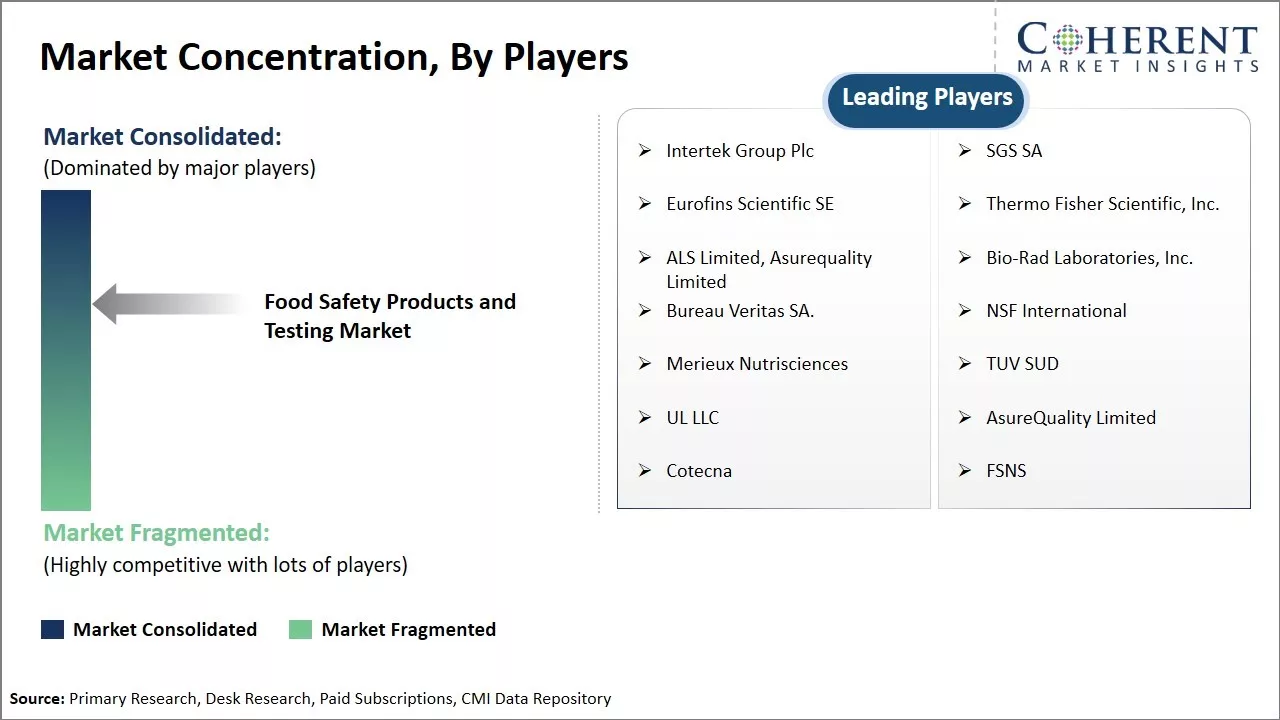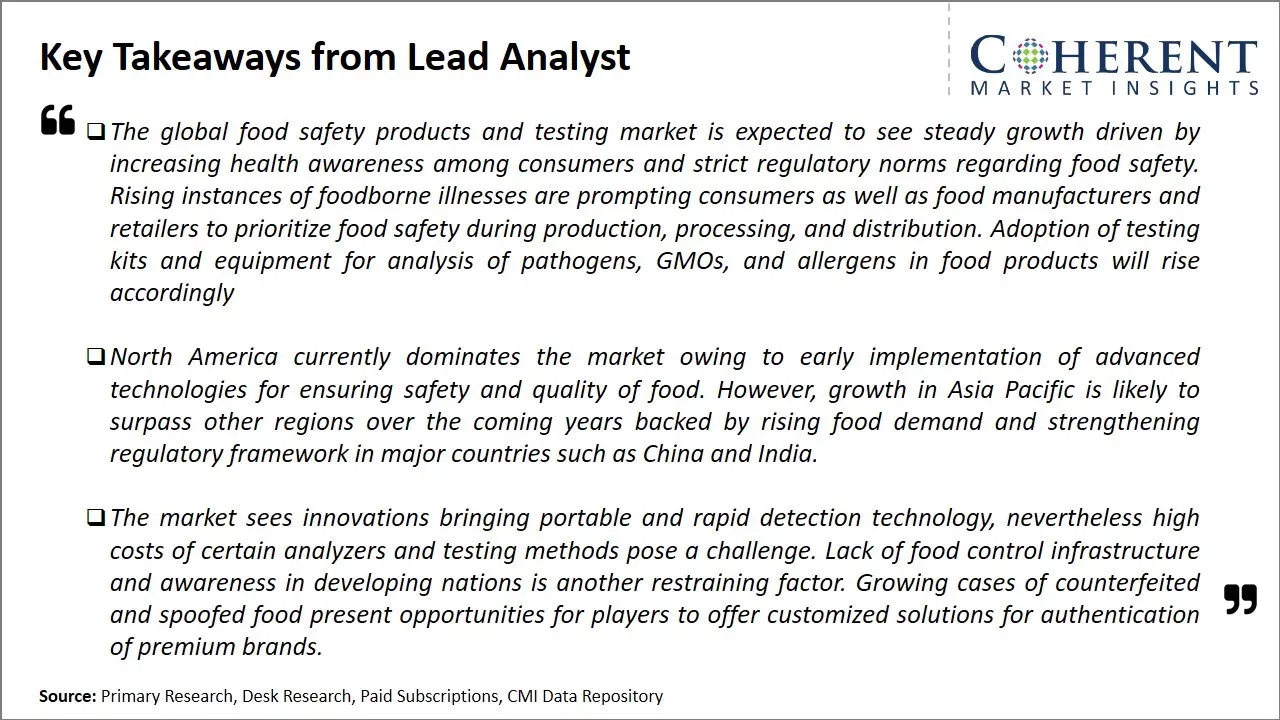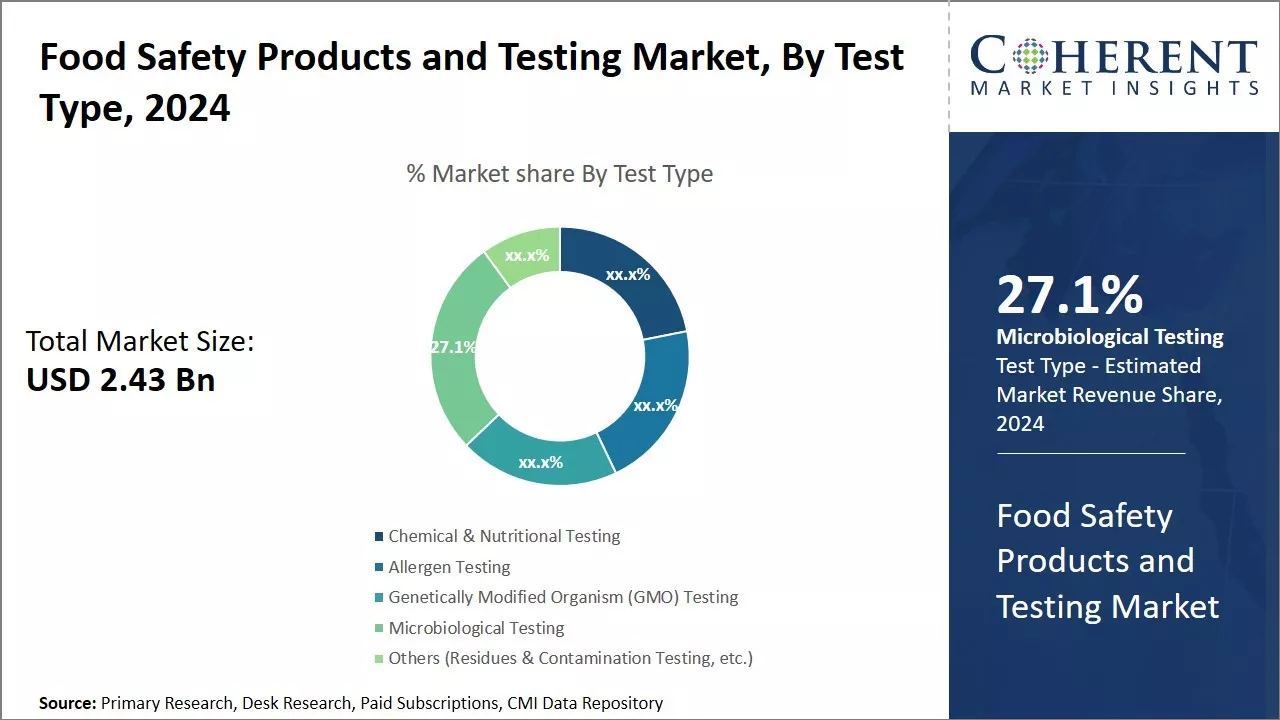The food safety products and testing market is estimated to be valued at USD 2.62 Bn in 2025 and is expected to reach USD 4.47 Bn by 2032, growing at a compound annual growth rate (CAGR) of 7.9% from 2025 to 2032.

Discover market dynamics shaping the industry: Request sample copy
The market is expected to witness significant growth over the forecast period. Stringent government regulations around food safety and hygiene are expected to drive increased demand for food safety products and testing. Growing instances of foodborne illness outbreaks are also compelling food producers and manufacturers to strengthen their food safety controls by opting for advanced testing equipment, kits, and services. Furthermore, the COVID-19 pandemic has raised awareness around health security and food safety, accelerating the adoption of testing and equipment across the food industry. Rapid technological advancements are also enabling improved detection methods and accuracy of food contamination testing. Wider access to hi-tech testing facilities globally through collaboration between public and private entities will further support the market expansion through 2032.
Concerns Regarding Foodborne Illnesses
As consumers have become more aware of food safety issues and concerns of contracting foodborne illnesses, the demand for ensuring the quality and integrity of the food supply has increased tremendously. In recent years, there have been several high profile outbreaks of foodborne diseases linked to contaminated foods that have caused illnesses and even deaths. The human and economic costs of foodborne diseases are enormous. It is estimated that each year in the U.S. alone, foodborne diseases cause around 76 million illnesses, 325,000 hospitalizations and 5,000 deaths. Some of the more common foodborne pathogens that pose serious risks include Salmonella, E. coli, Listeria monocytogenes, and Campylobacter amongst others. The effects of these illnesses can range from relatively mild gastroenteritis to more serious conditions like Guillain-Barré syndrome or even life threatening complications in high-risk groups such as young children, pregnant women, elderly, and immuno-compromised individuals. The human suffering and emotional trauma caused due to these diseases is difficult to quantify. Furthermore, the economic burden on the healthcare system and lost productivity is substantial. The costs associated with recalls of contaminated foods, litigation and damage to brand reputation also runs into millions for the food industry. With the increasing globalized and interconnected nature of the food supply chain, outbreaks can potentially have massive widespread effects.

Get actionable strategies to beat competition: Request sample copy
Implementation of Preventive ControlsAnother major factor propelling the food safety products and testing market growth is the strengthening of regulatory standards and compliance requirements globally to improve prevention and control of food safety hazards. For instance, in the U.S., the Food Safety Modernization Act (FSMA) signed in 2011 introduced sweeping reforms focused on shifting the regulatory approach from reactive to preventive. FSMA placed increased responsibility on food companies to implement comprehensive food safety plans based on hazard analysis and risk-based preventive controls.

To learn more about this report, Request sample copy
Market Challenges: Strict Regulations and StandardsThe food safety products and testing market faces several challenges. Strict regulations and standards across countries have increased compliance costs for businesses. The market also grapples with complex supply chains that make traceability and control difficult. Emerging pathogens continue to pose risks, while customers are more aware about food quality and demand transparency. These factors pressure companies to invest heavily in new testing methods and technologies. Additionally, the market sees challenges around data management and integrating separate testing solutions.
Market Opportunities: The rising threat of global foodborne illnesses
The rising threat of global foodborne illnesses and outbreaks have raised customer concerns and need for greater assurance. This increases the demand for advanced and automated solutions. Growth in the packaged and ready-to-eat food industries also drives the need for integrated testing platforms. The market sees opportunities to provide customized and portable testing kits tailored for different regions and products.

Discover high revenue pocket segments and roadmap to it: Request sample copy
Insights, By Test Type: Microbiological Testing Dominates the Food Safety MarketIn terms of test type, microbiological testing contributes 27.6% share of the food safety products and testing market owing to growing concerns over foodborne illnesses. Testing for microorganisms like pathogenic bacteria, yeasts, and molds has become imperative in ensuring the safety of foods. Recent outbreaks of foodborne diseases linked to contaminated food products have heightened awareness about the importance of microbiological quality control. Microbiological contamination remains one of the major causes of food spoilage and foodborne illnesses. Even in small numbers, certain microbes can cause serious diseases if consumed. With increasing globalization of food trade and changes in food production and handling practices, the risk of microbial contamination has amplified. Moreover, the demand for minimally processed and ready-to-eat foods has also increased the vulnerability to microbial hazards during various stages of the food chain. Considering their public health significance, governments across nations have made microbiological testing mandatory for many food categories.
Insights, By Application: Meat, Poultry and Seafood Dominate Food Safety Testing
In terms of application, meat, poultry & seafood products contributes 39.6% share of the food safety products and testing market owing to the high risk of pathogens in these foods. Meats are highly susceptible to microbial contamination as they provide ideal conditions for bacterial growth. Poultry products also require stringent safety checks since birds can easily be carriers of foodborne illnesses. Seafood is vulnerable to contamination due to its exposure to sea water and complex production processes involved. Given their significance as a major source of protein, meat and poultry items figure prominently in the world’s diet. However, consumption of contaminated meat, poultry or fish can lead to serious diseases like salmonellosis, campylobacteriosis, listeriosis, and toxoplasmosis. Meat has been linked to several foodborne disease outbreaks in the past. As a result, governments across nations mandate strict safety standards and extensive testing for pathogens in meat and poultry products before distribution. Regulators also screen seafood for bacteria, marine biotoxins, veterinary drug, and chemical residues on a regular basis. With the ever-rising demand for high-quality meat worldwide, producers focus heavily on safety checks to avoid economic losses from food recalls or trade restrictions. They conduct numerous microbial and chemical analysis at each phase of production to mitigate risks. Third-party audits and certification programs also ascertain compliance and build consumer confidence in the safety of protein foods. Altogether, the high risks involved and rigorous testing regimes make the meat, poultry and seafood segment the dominant application area in the food safety market. Growing consumption of meat product is expected to drive the market growth. For instance, in 2025, FAO and OECD estimate that the total poultry meat consumption will reach 91 million tons by 2032.

Need a Different Region or Segment? Customize now
The North America region has dominated the global food safety products and testing market over the past decade driven by stringent regulations around food safety and quality with 41.9% of the market share. With a large consumer base and strong economic conditions, food manufacturers in the U.S. and Canada are raising their standards to comply with the various federal and local laws enacted to ensure public health and safety. Key players from the U.S. like 3M, Agilent, Neogen, SGS, and Intertek have established their leadership in this domain with a wide portfolio of analytical instruments, test kits, and other solutions. The region also spearheads innovation with major R&D investments. Localization of production is another contributor, with companies setting up manufacturing units to serve the demand more effectively.
The fast growth of the Asia Pacific food industry has propelled the region to become a major force in the global market for food safety products and testing in recent years. Countries like China, India, and Japan now account for over half of the world's population and a growing middle-income consumers. Domestic food companies as well as multinationals setting up facilities in the region are investing heavily in safety solutions to gain consumer confidence and access international markets. Given the affordable costs and availability of skills, several global players have also established research centers, manufacturing, and sales facilities in countries like Singapore, South Korea, and Australia to leverage these benefits. Harmonizing regulations through collaborations, such as ASEAN, is further integrating this dynamic market.
Food Safety Products and Testing Market Report Coverage
| Report Coverage | Details | ||
|---|---|---|---|
| Base Year: | 2024 | Market Size in 2025: | USD 2.62 Bn |
| Historical Data for: | 2020 To 2024 | Forecast Period: | 2025 To 2032 |
| Forecast Period 2025 to 2032 CAGR: | 7.9% | 2032 Value Projection: | USD 4.47 Bn |
| Geographies covered: |
|
||
| Segments covered: |
|
||
| Companies covered: |
Intertek Group Plc, SGS SA, Eurofins Scientific SE, Thermo Fisher Scientific, Inc., ALS Limited, Asurequality Limited, Bio-Rad Laboratories, Inc., Bureau Veritas SA., NSF International, Merieux Nutrisciences, TUV SUD, UL LLC, AsureQuality Limited, Cotecna, and FSNS |
||
| Growth Drivers: |
|
||
| Restraints & Challenges: |
|
||
Uncover macros and micros vetted on 75+ parameters: Get instant access to report
*Definition: The food safety products and testing market consists of various instruments, solutions, and services used for ensuring the microbiological and chemical safety of food products. This includes sanitizers, disinfectants, and cleaning products that are used across the food processing and packaging industry. It also includes equipment, assays, and test kits that are used to detect pathogens, contaminants, allergens, and chemicals in food to ensure safety and compliance with regulatory standards.
Share
Share
About Author
Yash Doshi is a Senior Management Consultant. He has 12+ years of experience in conducting research and handling consulting projects across verticals in APAC, EMEA, and the Americas.
He brings strong acumen in helping chemical companies navigate complex challenges and identify growth opportunities. He has deep expertise across the chemicals value chain, including commodity, specialty and fine chemicals, plastics and polymers, and petrochemicals. Yash is a sought-after speaker at industry conferences and contributes to various publications on topics related commodity, specialty and fine chemicals, plastics and polymers, and petrochemicals.
Missing comfort of reading report in your local language? Find your preferred language :
Transform your Strategy with Exclusive Trending Reports :
Frequently Asked Questions
Joining thousands of companies around the world committed to making the Excellent Business Solutions.
View All Our Clients
US Reciprocal Tax Impact Analysis On Food Safety Products and Testing Market
Stay updated on tariff changes with expert insights and timely information